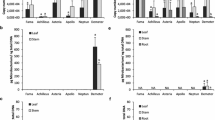Abstract
High densities of endophytic bacteria were found in plant material from poplar, larch and spruce that had been micropropagated for at least 5 years. The majority of these bacteria were assigned to the genus Paenibacillus based on the sequencing of the 16S rRNA genes. Other endophytic bacteria such as Methylobacterium, Stenotrophomonas or Bacillus could also be found but only in some tissue cultures. Certain species or strains of Paenibacillus, especially those with a close relationship to P. humicus, seemed to accumulate under in vitro conditions without visible negative influences on the plant’s development. Poplar microcuttings inoculated with the endophytic Paenibacillus isolate 22 showed significantly more roots per cutting and higher root length in comparison to the control plants after 3 weeks.

Similar content being viewed by others
Abbreviations
- Cfu:
-
Colony forming units
References
Beatty PH, Jensen SE (2002) Paenibacillus polymyxa produces fusaricidin-type antifungal antibiotics active against Leptosphaeria maculans, the causative agent of blackleg disease of canola. Can J Microbiol 48:159–169
Bent E, Chanway CP (2002) Potential for misidentification of a spore-forming Paenibacillus polymyxa isolate as an endophyte by using culture-based methods. Appl Environ Microbiol 68:4650–4652
Ewald D (2007) Micropropagation of Larix species via organogenesis. In: Jain SM, Häggman H (eds) Protocols for micropropagation of woody trees and fruits. Springer, Dordrecht
Ewald D, Hu JJ (2003) Efficiency in the formation of stable embryogenic lines and somatic embryo regeneration in Norway spruce and hybrid larch. Sci Silvae Sin 39:53–62
Ewald D, Hu JJ (2007) Influence of cytokinin and ammonium nitrate on elongation of adventitious buds in Norway Spruce (Picea abies). Sci Silvae Sin 43:28–43
Ewald D, Süss R (1993) A system for repeatable formation of elongating adventitious buds in Norway spruce tissue cultures. Silvae Genet 42:169–175
Ewald D, Zaspel I, Naujoks G et al (2000) Endogenous bacteria in tissue cultures of conifers – appearance and action. In: Cassells AC, Doyle BM, Curry RF (eds) Proceedings of the International Symposium on Methods and Markers for Quality Assurance in Micro propagation. Acta Hort 530:137–145
Fladung M, Kumar S, Ahuja MR (1997) Genetic transformation of Populus genotypes with different chimeric gene constructs: transformation efficiency and molecular analysis. Transgen Res 6:111–121
Holland MA, Polacco JC (1994) PPFMs and other covert contaminants: Is there more to plant physiology than just plant? Annu Rev Plant Physiol Plant Mol Biol 45:197–209
Leifert C, Cassells AC (2001) Microbial hazards in plant tissue and cell cultures. In vitro Cell Dev Biol Plant 37:133–138
Leifert C, Waites WM, Nicholas JR (1989) Bacterial contaminants of micropropagated plant cultures. J Appl Bacteriol 67:353–361
Moore PF, Barac T, Borremans B et al (2006) Endophytic bacterial diversity in poplar trees growing on a BTEX-contaminated site: the characterization of isolates with potential to enhance phytoremediation. Syst Appl Microbiol 29:539–556
Naujoks G, Zaspel I, Behrendt U (2000) Microorganisms acting in tissue culture of black locust (Robinia pseudoacacia L.). In: Cassells AC, Doyle BM, Curry RF (eds) Proceedings of the International Symposium on Methods and Markers for Quality Assurance in Micro propagation. Acta Hort 530:129–135
Sakiyama CCH, Paula EM, Pereira PC et al (2001) Characterization of pectin lyase produced by an endophytic strain isolated from coffee cherries. Lett Appl Microbiol 33:117–121
Schneck V, Ewald D (2001) Growth and performance of micropropagated hybrid larch clones. Silvae Genet 50:240–243
Tian YC, Zheng JB, Yu HM et al (2000) Studies of transgenic hybrid poplar carrying two insect-resistant genes. Acta Bot Sin 42:263–268
Timmusk S, Nicander B, Granhall U et al (1999) Cytokinin production by Paenibacillus polymyxa. Soil Biol Biochem 31:1847–1852
Ulrich K, Ulrich A, Ewald D (2008) Diversity of endophytic bacterial communities in poplar grown under field conditions. FEMS Microbiol Ecol 63:169–180
Yang M, Mi D, Ewald D et al (2006) Survival and escape of Argobacterium tumefaciens in triploid hybrid lines of Chinese white poplar transformed with two insect-resistant genes. Acta Ecol Sin 26:3555–3561
Acknowledgements
This work was supported by grant 0313285I from the Federal Ministry of Education and Research. We are grateful to Mrs. H. Enkisch for her excellent technical assistance. We also thank Prof. Yang from the Agricultural University Hebei, Baoding for providing the poplar clone 741 including several transgenic lines and the white poplar clone, and Dr. M. Fladung and Dr. I. Zaspel for providing plant materials from poplar and black locust clones, respectively.
Author information
Authors and Affiliations
Corresponding author
Rights and permissions
About this article
Cite this article
Ulrich, K., Stauber, T. & Ewald, D. Paenibacillus—a predominant endophytic bacterium colonising tissue cultures of woody plants. Plant Cell Tiss Organ Cult 93, 347–351 (2008). https://doi.org/10.1007/s11240-008-9367-z
Received:
Accepted:
Published:
Issue Date:
DOI: https://doi.org/10.1007/s11240-008-9367-z




